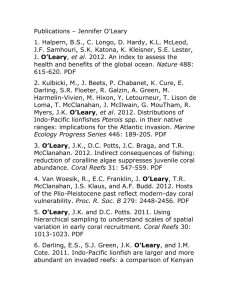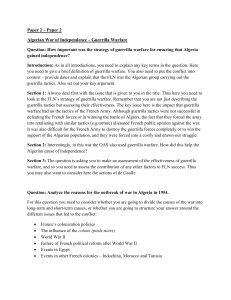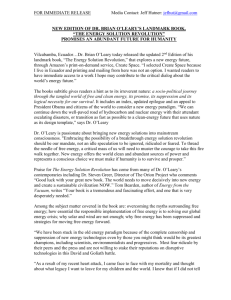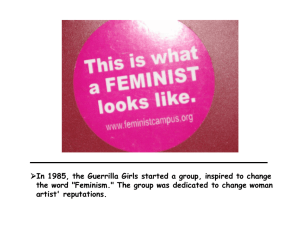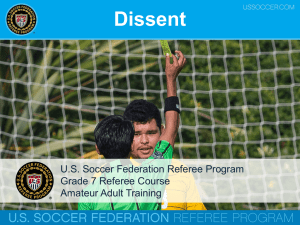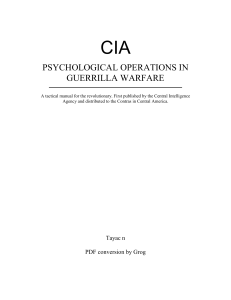Administrative Discretion and the Ethics of Dissent
advertisement
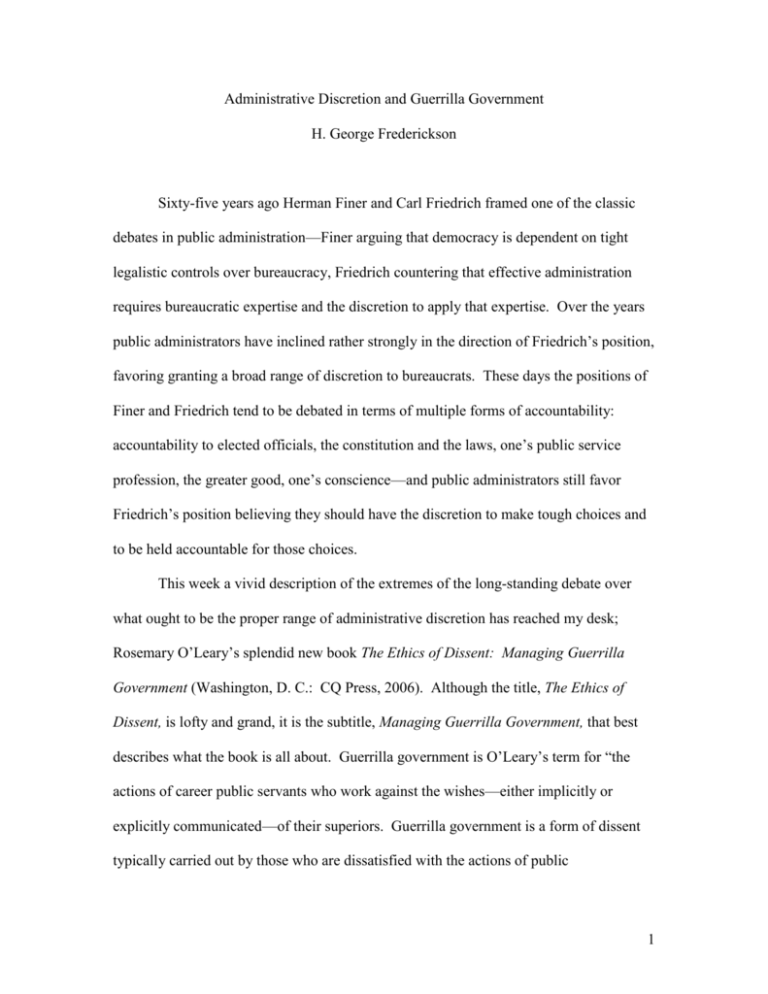
Administrative Discretion and Guerrilla Government H. George Frederickson Sixty-five years ago Herman Finer and Carl Friedrich framed one of the classic debates in public administration—Finer arguing that democracy is dependent on tight legalistic controls over bureaucracy, Friedrich countering that effective administration requires bureaucratic expertise and the discretion to apply that expertise. Over the years public administrators have inclined rather strongly in the direction of Friedrich’s position, favoring granting a broad range of discretion to bureaucrats. These days the positions of Finer and Friedrich tend to be debated in terms of multiple forms of accountability: accountability to elected officials, the constitution and the laws, one’s public service profession, the greater good, one’s conscience—and public administrators still favor Friedrich’s position believing they should have the discretion to make tough choices and to be held accountable for those choices. This week a vivid description of the extremes of the long-standing debate over what ought to be the proper range of administrative discretion has reached my desk; Rosemary O’Leary’s splendid new book The Ethics of Dissent: Managing Guerrilla Government (Washington, D. C.: CQ Press, 2006). Although the title, The Ethics of Dissent, is lofty and grand, it is the subtitle, Managing Guerrilla Government, that best describes what the book is all about. Guerrilla government is O’Leary’s term for “the actions of career public servants who work against the wishes—either implicitly or explicitly communicated—of their superiors. Guerrilla government is a form of dissent typically carried out by those who are dissatisfied with the actions of public 1 organizations, programs, or people but who typically, for strategic reasons, choose not to go public with their concerns. . .” (p. xi). Based on more than three dozen actual cases— the cases are mostly rather brief first-person accounts and stories—which include the names of the guerrillas, what they did, and how they did it, O’Leary provides a powerful and very readable empirical base for her findings and generalizations. O’Leary’s guerrillas include Mark Felt, the “Deep Throat” of Watergate fame and Chiune Sugihara, the Japanese diplomat stationed in Lithuania, who, in the summer of 1940, against the policies of the Japanese government, issued visas to over 10,000 Jews, enabling them to escape the Holocaust. Unlike Felt and Sugihara and other high-profile guerrillas, most of O’Leary’s guerrillas are garden variety nameless and faceless civil servants. There are more bureaucratic guerrillas than one might think, and guerrilla warfare in the bureaucratic trenches is far more common than one might think. Indeed, “guerrilla government happens all the time in the everyday, often mundane world of bureaucracy. Sometimes guerrillas fail to correct superiors’ mistakes and let them fall. Sometimes guerrillas fail to implement orders they think are unfair. At times guerrilla government manifests itself as the ghostwriting of letters and testimony for interest groups. At other times it may mean forging secret links with nongovernmental organizations. It may mean leaking information to the news media. There are as many variations of guerrilla government as there are variations in guerrillas” (p. 3). The guerrilla repertoire also includes these familiar tactics: going over your supervisor’s head, and over that supervisor’s head, and so forth; filing a lawsuit; obeying in public, disobeying in private; cultivating the media; leaking to the media; creating or arrange for the creation of documentaries, scientific studies, and scientific papers that support a 2 particular position; forging links with professional, nongovernmental, and citizen organizations; lobbying; testifying; contacting the White House of the State House; stalling; holding clandestine meetings; tying your cause to a crisis or event; raising funds. It is clear that guerrilla government is not bean-bag or tiddly-winks; it is, instead, a rough game played by tough policy partisans. As O’Leary puts it, “all guerrilla activity is not created equally.” She describes, for example, the guerrilla who had a long-running battle with superiors that began when a consultant refused a reimbursement for a five-dollar hamburger and the guerrilla then “waged a clandestine war to have the consultant barred from future state contracts and his supervisor fired.” But most of O’Leary’s cases are about serious matters associated with policy differences, questions of fairness, and interpretations of laws and regulations and how they should be implemented. She reports the results of a survey of Fellows of the National Academy of Public Administration who almost unanimously agreed that “dissent, when managed properly, was not only positive but essential to a healthy organization” (p. 104). Sean O’Keefe, the former administrator of the National Aeronautics and Space Administration, indicated to O’Leary that “embracing dissent means inviting diversity of opinion from the people around you. My first rule is to never surround myself with people who are just like me. My second rule is always to insist upon someone voicing the dissenting opinion” (p. 104). At their best, guerrillas are the canaries of government, the early warning system. “Instead of discussing guerrillas as problematic and plotting how to get rid of them, we can think of guerrillas as messengers coming to tell a manager something important about the organization, the policies, and the way of operation. . . . The real challenge is to see if we can listen to the guerrillas’ 3 messages, sift through the canaries and the zealots, really hear them and take them to heart, that is, make the connection to the broader reality of public management and policy challenges at hand more fully” (pp. 104-108). O’Leary’s primary findings and conclusions are grounded in a synthesis of her cases and are these: (1) guerrilla government is here to stay; (2) guerrillas can do it to you in ways you will never know; (3) all guerrilla activity is not created equal; (4) most public organizations are inadequately equipped to deal effectively with guerrilla government; (5) the tensions inherent in guerrilla government will never be resolved. These findings will disappoint those looking for breakthroughs or easy answers, but they are a clear-eyed and accurate description of how bureaucratic dissent actually works. Having made these findings and conclusions, O’Leary turned to the pros for advice. In summary form that advice is: (1) create an organizational culture that accepts, welcomes, and encourages candid dialogue and debate; (2) listen; (3) understand the formal and informal organization; (4) separate the people from the problem; (5) create multiple channels for dissent; (6) create dissent boundaries and know when to stop. Based on her survey of the pros, O’Leary’s advice is at once simple and profound. Welcoming dissent, listening, separating people from problems, and allowing multiple dissent channels may be simple and profound, but are not easy for managers. They are skills that must be learned and are most often learned by experience, a notoriously expensive way to learn. O’Leary’s advice is a little scholarship to those who should learn these skills while avoiding the high cost of learning everything by experience. If we favor the special place of expertise in the civil service and broads grants of discretion to apply that expertise, and we do, with that discretion comes accountability in 4 all its forms. That accountability includes the management of dissent in one’s agency and responsibility for the bureaucrats in one’s agency who choose to be guerrillas. Rosemary O’Leary has written an excellent handbook for public administrators with such responsibilities, for those who aspire to such responsibilities, and for those who study and teach those who aspire to such responsibilities. I agree with Donald F. Kettl’s observation in the book’s foreword that The Ethics of Dissent: Managing Guerrilla Government “stands as one of the most insightful works on the real world of bureaucracy ever written.” 5


